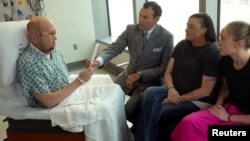A man has undergone the first ever eye transplant, bringing hope for the future restoration of vision.
The first ever full human eye transplant has been successfully carried out by surgeons, making it an incredible advancement in face transplants. However, it is still too early to determine if the recipient will regain sight in his new left eye.
An accident with high-voltage power lines destroyed most of Aaron James’ face and one eye. His right eye still works. But surgeons at NYU Langone Health hoped replacing the missing one would yield better cosmetic results for his new face, because it would support the transplanted eye socket and lid.
On Thursday, the NYU team reported that they have been successful in their efforts. James is making good progress following his double transplant in May and the transplanted eye appears to be in excellent condition.
James updated The Associated Press on his recovery, expressing that he is pleased with his progress thus far. Despite not being able to move or blink his eyelid, he is starting to regain sensation.
According to James, a 46-year-old resident of Hot Springs, Arkansas, everyone has to begin somewhere and there will always be a first person to do so. Perhaps this experience can provide valuable lessons for those who come after.
Currently, corneal transplants are frequently performed to address specific forms of vision impairment. However, the transplantation of the entire eye, including the eyeball, its blood supply, and the crucial optic nerve that links it to the brain, is seen as a monumental challenge in the pursuit of curing blindness.
Regardless of the outcome, James’ surgery provides researchers with a unique opportunity to observe the healing process of the human eye.
Dr. Eduardo Rodriguez, the head of plastic surgery at NYU who oversaw the transplant, stated, “We are not making the claim that we will fully restore vision. However, I firmly believe that we have taken one step closer.”
Experts had worried that the eye would rapidly shrink, resembling a raisin. However, when Rodriguez held open James’ left eyelid in the previous month, the gifted hazel eye appeared just as plump and filled with fluid as his own blue eye. Physicians observe positive blood circulation and no indication of rejection.
Researchers are currently examining scans of James’ brain that revealed unusual signals coming from the damaged optic nerve, which plays a crucial role in vision.
A renowned researcher who has extensively investigated the feasibility of eye transplants described the procedure as thrilling.
Dr. Jeffrey Goldberg, chair of ophthalmology at Stanford University, described it as an incredible confirmation of animal studies that have successfully maintained transplanted eyes in a living state.
According to Goldberg, the challenge lies in finding a way to regenerate the optic nerve. While animal experiments are showing progress, he commended the NYU team’s boldness in attempting to repair the optic nerve and expressed his desire for the transplant to inspire further study.
“We are at the verge of being able to accomplish this,” Goldberg stated.
In June 2021, James was employed by a power line company when he suffered an electric shock from a live wire, nearly resulting in his death. As a result, he lost his left arm and needed a prosthetic to replace it. His left eye was also severely damaged and had to be removed due to intense pain. Despite undergoing multiple reconstructive surgeries, his facial injuries, including the loss of his nose and lips, could not be fully repaired.
James persevered in his physical rehabilitation until he regained enough strength to accompany his daughter Allie to her high school homecoming event. Despite the challenges of wearing a face mask and eye patch, he still needed assistance with breathing and eating through tubes. He yearned for the ability to fully experience the senses of smell, taste, and eating solid food once more.
According to Meagan James, her husband’s lack of a nose did not affect her feelings towards him, as she saw him for who he truly was. However, she did concern herself with how it affected him emotionally.
Face transplants remain rare and risky. James’ is only the 19th in the United States, the fifth Rodriguez has performed. The eye experiment added even more complexity. But James figured he’d be no worse off if the donated eye failed.
After three months of being on the national transplant waiting list, James received news that a suitable donor had been found. The donor, a man in his 30s, provided kidneys, a liver, and a pancreas that were able to save the lives of three other individuals.
The surgeons made an additional attempt during James’ 21-hour surgery by injecting special stem cells from the donor into the spliced optic nerve in hopes of promoting its healing.
In the previous month, tingling sensations indicated that the facial nerves were beginning to heal. James is still unable to open his eyelid and has to wear a patch for protection. However, when Rodriguez applied pressure to the closed eye, James experienced a feeling, although it was on his nose rather than his eyelid. This is likely because the nerves are still adjusting. The surgeon also noticed small movements starting to occur in the muscles around the eye.
After that, a more detailed examination was conducted by Dr. Vaidehi Dedania, an ophthalmologist from NYU. She performed a series of tests and discovered the anticipated harm to the retina, which is responsible for sensing light at the back of the eye. However, she noted that there are enough specialized cells, known as photoreceptors, to perform the task of converting light into electrical signals, which is one of the steps involved in creating vision.
Typically, the nerve responsible for vision would transmit these signals to the brain for processing. However, James’ optic nerve has not fully recovered. Surprisingly, when light was shone into the transplanted eye during an MRI, the scan detected some form of brain activity.
Dr. Steven Galetta, chair of neurology at NYU, cautioned that while researchers were both excited and confused by this discovery, it may not be relevant to vision and could possibly just be a coincidence. Only further investigation and time will reveal the true significance.
James stated, “We are simply approaching each day as it comes.”
Source: voanews.com





